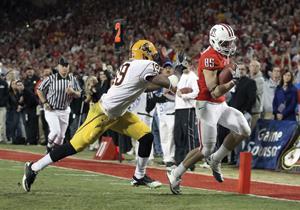The happiest people to hear about the Pac-10’s eye-popping $3 billion TV deal have to be executives with any sports property that’s getting ready to negotiate media rights.
The Big East deal is the next one being negotiated. I’ll be shocked if the conference doesn’t at least triple its media rights haul.
I never thought the Olympics would be able to come close to the $2 billion NBC and GE paid for the 2010 and 2012 Games. Now, I’m not so sure. I still think the International Olympic Committee will have a hard time matching that number for the 2014 and 2016 Games, which will be awarded in June.
Can rights fees increase after NBC reported a loss of $200 million on the Vancouver Games? After reporting on the NHL and Pac-10’s media deals in the last few weeks, I wouldn’t be surprised.
| 
GETTY IMAGES
With the new Pac-10 deal, the media rights run-up continues. |
I’ve never seen a market as hot as the one that currently exists for sports media rights.
Every deal this year has seen TV networks shell out at least two times more — on an annual average — than previous deals. It doesn’t seem to matter what the sport is or whether rights are local or national. TV networks clearly want sports on their schedules and are prepared to pay for them.
In the last three months, for example:
• Time Warner Cable agreed to pay an average of $200 million a year for the local media rights to the Lakers, according to published reports. That’s more than three times the $60 million a year the team gets from its current deals with Fox Sports Net and KCAL9.
• Fox Soccer tripled the annual average it will pay to MLS this year, increasing its rights fee from $2 million to $6.75 million for this season.
• Fox agreed to pay the Big 12 an average of $90 million annually, an increase of 350 percent from the current deal, which is worth $20 million a year.
• NBC and Versus nearly tripled the average annual amount they’ll pay for NHL rights, from $78 million to $187 million.
• Now ESPN and Fox are going to pay an annual average of $250 million for the Pac-10’s rights, a figure that’s more than four times higher than the average payout of the current deal of $58 million.
Comparing the average annual costs of these deals is somewhat misleading. Because annual increases are built into the contracts, the final season of the old deal and the first season of the new deal are much closer than these numbers indicate. But even with that caveat, the market is scalding hot, and TV executives typically cite three reasons.
First, competition is intense, with ESPN, Fox, NBC and Turner battling for rights. More bidders means higher rights fees. NBC wants to bring more sports to Versus; Turner wants to bring more sports to truTV; and Fox wants to bring more sports to FX. And don’t forget distributors, like Comcast and Time Warner Cable, that have been at the negotiating table for several deals.
Second, TV network executives have said that college sports rights, in particular, have been undervalued. They believe we’re in the middle of a market correction.
Five years ago, the Big East signed a deal with an average annual payout — $36 million — that seems laughably low by today’s standards. It’s no surprise that the conference is negotiating an increase that would see it get more than $130 million a year.
Third, live events rate. It’s not just sports, but all live events. ESPN research says that 99 of the 100 highest-rated TV telecasts last year were live (sports, “American Idol,” awards shows) in the 18-49 demographic that advertisers covet.
Because advertisers want to reach that demo, competition to pick up these rights is as intense as ever. Viewers watch these events live. They generally don’t DVR them. Those are the types of shows that advertisers want to buy.
This market, where annual rights fees double and triple, will slow down eventually. It has to, doesn’t it? The market will find its ceiling at some point.
Until then, leagues and conferences will continue to be the biggest beneficiaries of the wildest marketplace I’ve ever seen.
John Ourand can be reached at jourand@sportsbusinessjournal.com. Follow him on Twitter @Ourand_SBJ.





